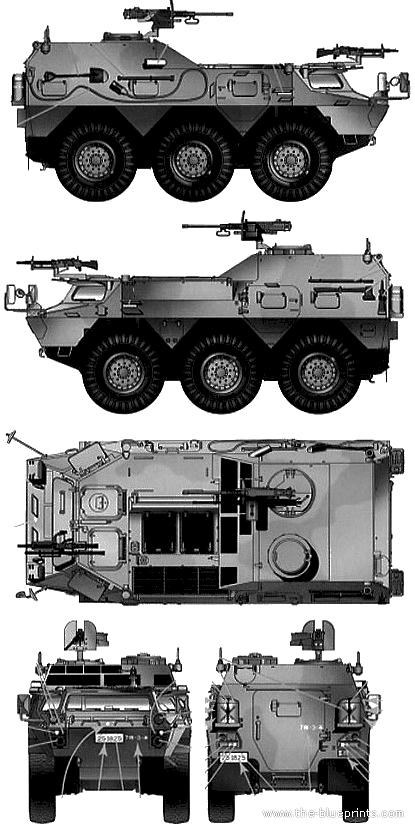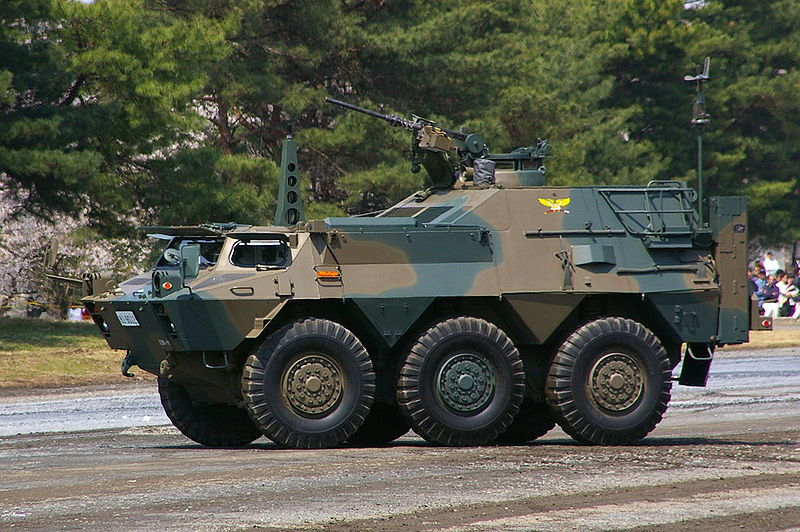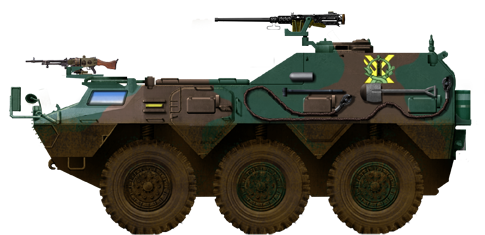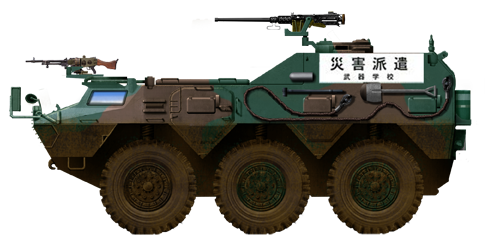Mistubishi's C2 AFV
Command and Communications vehicles ("C2" for short) are useful providers of critical situational and battlefield awareness for ground commanders, data link and relay and coordination platform with the general HQ. Modern field armies always integrated those vehicles when possible. A reflection for a dedicated vehicle was started in Japan in the early 1970s and by mid-1975 the Japanese Ground Self-Defense Force launched a program aimed at providing a vehicle, to be studied by Mistubishi, the most likely to provide R&D for it. The design team looked after various 4x4 and 6x6 solutions and tested existed vehicles, until settling on the 6x6 configurations. The next step was to carry on a chassis, based on existing elements, called by the army "Type 82 Command and Communications Vehicle".This 6x6 wheeled vehicle was fast while keeping excellent off-road capabilities and sufficient redundancy in adverse off-road conditions; Cross-country mobility, to follow armoured units on the field, equipped with tracked vehicles, was indeed a core requirement for the general staff. In the end, the final vehicle in 1980 and after many alterations ompleted all its trials with success. It was followed by initial order of ten preserie vehicles for further field tests in active units, provided to the JGSDF in 1982 ("hence the type 82"). After these advanced army trials, a final order was passed, of 250 units. Since Mitsubishi was already underwater, Komatsu was given the production contract. In total it was established to 231 vehicles, even more than the type 87 AFV which was derived from its chassis by Komatsu. The vehicle is still in service today, but was not exported or declined to any variants. Prospects for a modernization or replacement are ongoing since the last decade.
Design of the Type 82
Hull & protection
The main hull of the vehicle rests on a 6x6 chassis, atop of which is constructed a simple lightly-armored superstructure. The forward and middle compartment together can be operated by three. This is a driver's compartment front-right, with large window panels backed by fold-down protective shutters with vision provided slits for high intensity operation. The roof is dotted with hatches, one for the two remaining crewmen. The rear cabin is caracterized by an aft oversized section. While engine is located on the left side there is still a tunnel giving forward and rear access. The back is given a large door for quick embarking and disembarking of the operators, possibly to operate dismpinted. There is another door on the left side. The three side folding shutters have right firing ports to use small arms on the way. For night vision, the driver is given an infrared sight.The angled superstructure provided artificial extra armor thickness for improved ballistics protection. The 6 mm plates on the sides and back, roof are completed by a 12 mm front angled plates, protecting from small arms fire and artillery shrapnel. Despite it was the 1980s, the vehicle was not provided with any collective NBC system. For this, the crew had to operate with indivdual protective suits and gear. There is no known protection against mines.

Five view - The Blueprints.com
powerplant & mobility
The vehicle's Powerplan chosen was the Izuzu 10PBI water-cooled diesel engine. It is rated for 305 horsepower at 2,700rpm. It provided the Type 82 with a road speed up to 100 km/h on flat (62 mph), the diesel giving an operational range of 500 kilometers (310 miles). The vehicle was tested on all sorts of terrains and climatic conditions, and was able to start and operate at -20°, or under tropical heat (although there is no proper air conditioning system). The Type 82 was found able to ford 1 meter deep rivers, climb a 0.6 meters wall or obstacle, gap a 1.5 m trench and stay stable and climb a slope up to 60% and 30% side slope. At 13 tonnes it can cross most bridges in Japan and be carried by heavy duty transports such as the Kawasaki C2, however it is not amphibious (no trim vane, no buoyancy, no propellers or bilge pump). The six road wheels all had independent axles, and are suspended on vertical coil springs. The large tires close together give excellent ground clearance and grip over soft surfaces. There is however no known central tire inflation system but the loss of one tire has been tested.Armament
Defensive armament is provided, outside the three crew member individual weapons: There is a simple 12.7mm heavy machine gun (0.5 cal. M2HB) placed around the commander's hatch at the rear, and a 7.62mm medium machine gun provided to the co-driver. 2000s modernization standards includes the replacement of the cal.50 by a remote weapons station of the same. The vehicle does not possessed any means of active protection (smoke dischargers).Deployments
So far, the vehicle only participated in homeland exercises and manoeuvers. This vehicle however was central in Peace Keeping Operations, notably in Cambodia, painted white with large blue "UN" over.
Chemical Reconnaissance VARIANT
Specs. Type 82 | |
| Dimensions (l-w-h): | 5.72 x 2.48 x 2.37 m (18'8'' x 8'1'' x 7'8'') |
| Total weight, battle ready: | 13.5 Tonnes/14.9 tons (29,000 ibs) |
| Crew : | 3 (Driver, Ass. driver, Command operator) |
| Propulsion: | Isuzu 10PBI 10-cyl wc diesel 305 hp |
| Suspensions: | Vert. Coil springs |
| Top Speed (flat) | 100 kph (65 mph) |
| Range (road) | 500 km (310 miles) |
| Armament | 0.5 in cal HMG (12.7 mm), 0.3 in LMG (7.92 mm) |
| Armour | 8 mm (0.3 in) |
| Total Production | 231 |


Author's Illustrations of the Type 87 (click on the first to see the HD)
Links/src
The Type-82 on Army-GuideThe Type-82 on warwheels.net
The Type-82 on tanknutdave
Type-82 model kit, Pit-road 1/35
The Type-82 on military factory
The Type-87 on wikipedia japan
Type-87 Gallery
Note: All Creative Commons, from LOS688

Cold War Tanks


































Cold war tanks posters

Cold War Main Battle Tanks

Cold War Soviet Army
Museums, Movies, Books & Games
The Tanks and Armor in pop culture
Tanks and armored vehicles in general are only really grasped when seen first person: The mass, the scale, it's all there. Explore also the way tanks were covered in the movie industry, in books and in video games.Movies:
Best tanks movie on warhistoryonline.com
On imdb.com
On bestsimilar.com/
miltours.com
liveabout.com/
watchmojo.com
Video Games:
pcgamesn.com
historyhit.com
levvvel.com
vg247.com/best-tank-games
mmobomb.com/
alienwarearena.com

